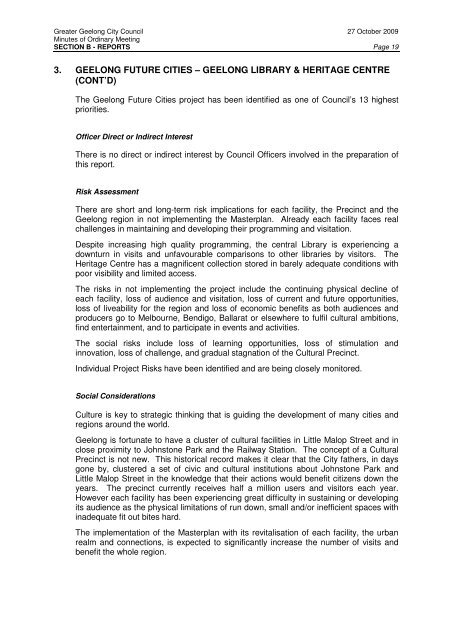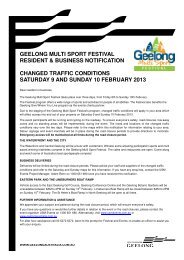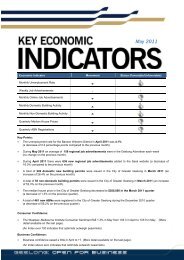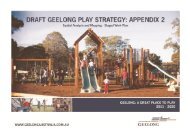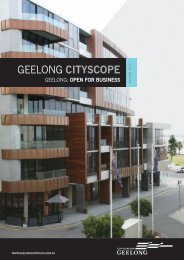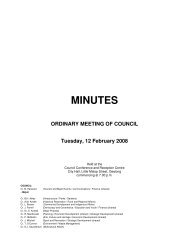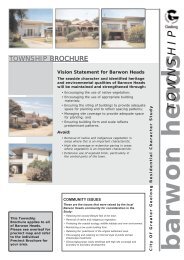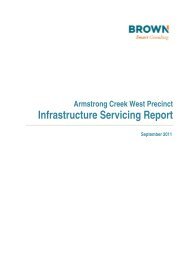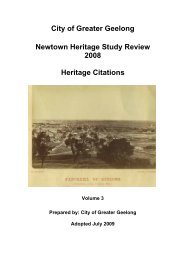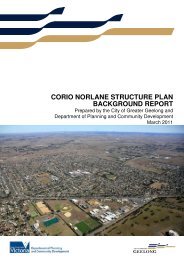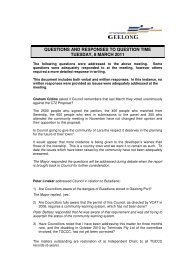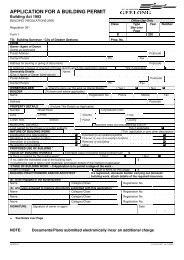Council Minutes - 27 October 2009 - City of Greater Geelong
Council Minutes - 27 October 2009 - City of Greater Geelong
Council Minutes - 27 October 2009 - City of Greater Geelong
You also want an ePaper? Increase the reach of your titles
YUMPU automatically turns print PDFs into web optimized ePapers that Google loves.
<strong>Greater</strong> <strong>Geelong</strong> <strong>City</strong> <strong>Council</strong> <strong>27</strong> <strong>October</strong> <strong>2009</strong><br />
<strong>Minutes</strong> <strong>of</strong> Ordinary Meeting<br />
SECTION B - REPORTS Page 19<br />
3. GEELONG FUTURE CITIES – GEELONG LIBRARY & HERITAGE CENTRE<br />
(CONT’D)<br />
The <strong>Geelong</strong> Future Cities project has been identified as one <strong>of</strong> <strong>Council</strong>’s 13 highest<br />
priorities.<br />
Officer Direct or Indirect Interest<br />
There is no direct or indirect interest by <strong>Council</strong> Officers involved in the preparation <strong>of</strong><br />
this report.<br />
Risk Assessment<br />
There are short and long-term risk implications for each facility, the Precinct and the<br />
<strong>Geelong</strong> region in not implementing the Masterplan. Already each facility faces real<br />
challenges in maintaining and developing their programming and visitation.<br />
Despite increasing high quality programming, the central Library is experiencing a<br />
downturn in visits and unfavourable comparisons to other libraries by visitors. The<br />
Heritage Centre has a magnificent collection stored in barely adequate conditions with<br />
poor visibility and limited access.<br />
The risks in not implementing the project include the continuing physical decline <strong>of</strong><br />
each facility, loss <strong>of</strong> audience and visitation, loss <strong>of</strong> current and future opportunities,<br />
loss <strong>of</strong> liveability for the region and loss <strong>of</strong> economic benefits as both audiences and<br />
producers go to Melbourne, Bendigo, Ballarat or elsewhere to fulfil cultural ambitions,<br />
find entertainment, and to participate in events and activities.<br />
The social risks include loss <strong>of</strong> learning opportunities, loss <strong>of</strong> stimulation and<br />
innovation, loss <strong>of</strong> challenge, and gradual stagnation <strong>of</strong> the Cultural Precinct.<br />
Individual Project Risks have been identified and are being closely monitored.<br />
Social Considerations<br />
Culture is key to strategic thinking that is guiding the development <strong>of</strong> many cities and<br />
regions around the world.<br />
<strong>Geelong</strong> is fortunate to have a cluster <strong>of</strong> cultural facilities in Little Malop Street and in<br />
close proximity to Johnstone Park and the Railway Station. The concept <strong>of</strong> a Cultural<br />
Precinct is not new. This historical record makes it clear that the <strong>City</strong> fathers, in days<br />
gone by, clustered a set <strong>of</strong> civic and cultural institutions about Johnstone Park and<br />
Little Malop Street in the knowledge that their actions would benefit citizens down the<br />
years. The precinct currently receives half a million users and visitors each year.<br />
However each facility has been experiencing great difficulty in sustaining or developing<br />
its audience as the physical limitations <strong>of</strong> run down, small and/or inefficient spaces with<br />
inadequate fit out bites hard.<br />
The implementation <strong>of</strong> the Masterplan with its revitalisation <strong>of</strong> each facility, the urban<br />
realm and connections, is expected to significantly increase the number <strong>of</strong> visits and<br />
benefit the whole region.


